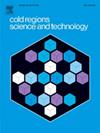A numerical study of process complexity in permafrost dominated regions
IF 3.8
2区 工程技术
Q1 ENGINEERING, CIVIL
引用次数: 0
Abstract
Numerical modeling of permafrost dynamics requires adequate representation of atmospheric and surface processes, a reasonable parameter estimation strategy, and site-specific model development. The three main research objectives of the study are: (i) to propose a novel methodology that determines the required level of surface process complexity of permafrost models by conducting parameter sensitivity and calibration, (ii) to design and compare three numerical models of increasing surface process complexity, and (iii) to calibrate and validate the numerical models at the Yakou catchment on the Qinghai-Tibet Plateau as an exemplary study site. The calibration was carried out by coupling the Advanced Terrestrial Simulator (numerical model) and PEST (calibration tool). Simulation results showed that (i) A simple numerical model that considers only subsurface processes can simulate active layer development with the same accuracy as other more complex models that include surface processes. (ii) Peat and mineral soil layer permeability, Van Genuchten alpha, and porosity are highly sensitive. (iii) Liquid precipitation aids in increasing the rate of permafrost degradation. (iv) Deposition of snow insulated the subsurface during the thaw initiation period. We have developed and released an integrated code that couples the numerical software ATS to the calibration software PEST. The numerical model can be further used to determine the impacts of climate change on permafrost degradation.

求助全文
约1分钟内获得全文
求助全文
来源期刊

Cold Regions Science and Technology
工程技术-地球科学综合
CiteScore
7.40
自引率
12.20%
发文量
209
审稿时长
4.9 months
期刊介绍:
Cold Regions Science and Technology is an international journal dealing with the science and technical problems of cold environments in both the polar regions and more temperate locations. It includes fundamental aspects of cryospheric sciences which have applications for cold regions problems as well as engineering topics which relate to the cryosphere.
Emphasis is given to applied science with broad coverage of the physical and mechanical aspects of ice (including glaciers and sea ice), snow and snow avalanches, ice-water systems, ice-bonded soils and permafrost.
Relevant aspects of Earth science, materials science, offshore and river ice engineering are also of primary interest. These include icing of ships and structures as well as trafficability in cold environments. Technological advances for cold regions in research, development, and engineering practice are relevant to the journal. Theoretical papers must include a detailed discussion of the potential application of the theory to address cold regions problems. The journal serves a wide range of specialists, providing a medium for interdisciplinary communication and a convenient source of reference.
 求助内容:
求助内容: 应助结果提醒方式:
应助结果提醒方式:


